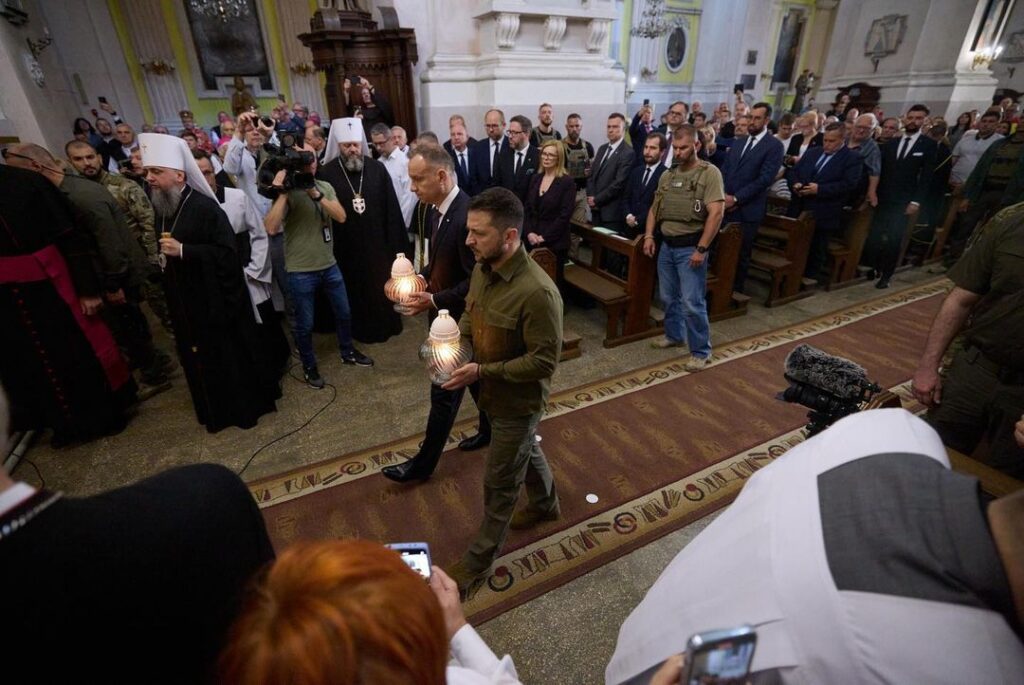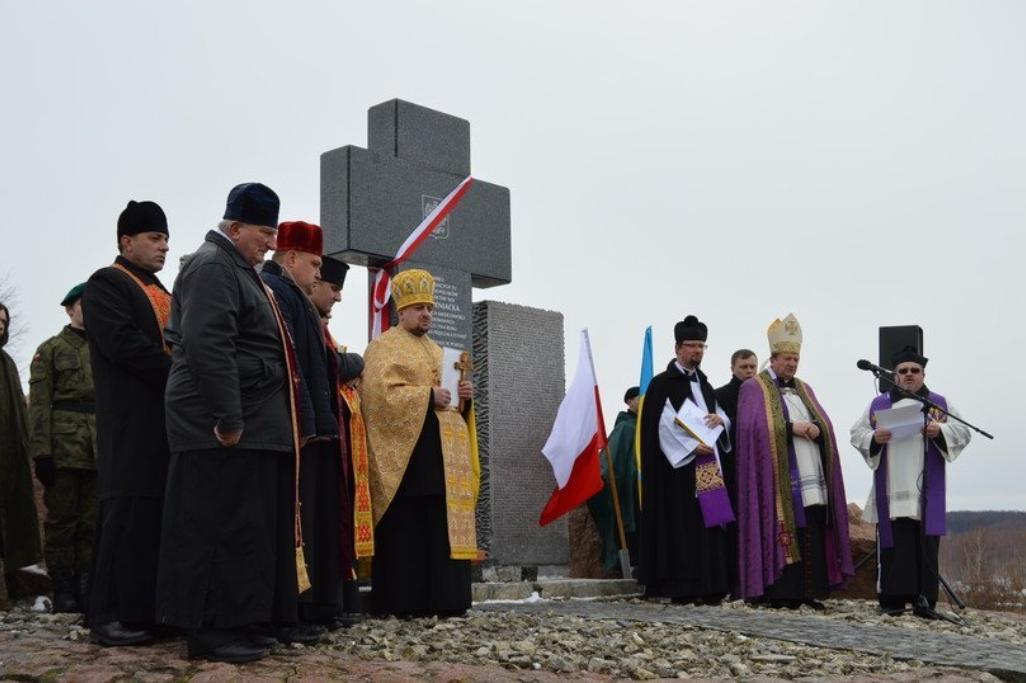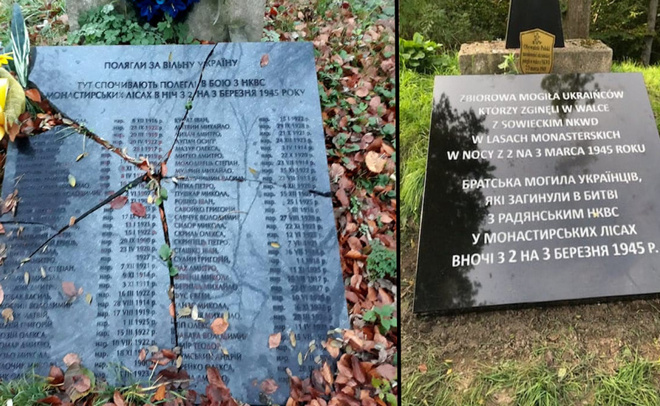Ukraine's cordial relationship with Poland has hit a rocky patch as ghosts from the turbulent mid-20th century return with a vengeance.
The Volyn tragedy, called a massacre in Poland, mass killings of Polish civilians by the Ukrainian Insurgent Army (UPA) during World War II, has long been an open wound for Polish-Ukrainian relations. However, now the historical grievances have become a roadblock to Ukraine's strategic EU membership.
While Poland frames the tragedy as a unilateral Ukrainian "genocide" of Poles, Ukraine insists that mutual animosity and territorial disputes predated the killings and stresses that the violence went both ways.
A particular bone of contention is UPA leader Stepan Bandera. His veneration in Ukraine as a symbol of the fight for independence during WWII has drawn condemnation from Polish officials, who view him as responsible for the Volyn tragedy.
The tensions culminated when Poland's Prime Minister Donald Tusk declared that Ukraine's path to EU membership hinges on resolving its historical disputes with Poland, particularly Volyn, and Defense Minister Władysław Kosiniak-Kamysz suggested that Poland might block Ukraine's EU membership unless the "Volyn issue" is addressed.
This rhetoric marked a sharp U-turn compared to Warsaw's previous stance, which had pushed for Ukraine's fast-tracked accession to the EU and NATO.
It also raises questions about the fate of a pivotal security partnership crucial to resisting Russia's ongoing war. Early in Russia's full-scale invasion, Poland emerged as Ukraine's key partner, pressing hard for Western military aid and becoming a vital lifeline for assistance pouring into Ukraine. Bound by the shared threat, the two nations shaped an alliance that proved crucial to shore up Ukraine’s resistance and keep Russia from gaining a stronger foothold in Europe.
Is this alliance now under question, what is the truth about Volyn, and will Poland really block Ukraine's EU membership over historical grievances? Euromaidan Press investigates.
Reopening Pandora's box
The discord in the bilateral relations peaked after 30 August 2024, when Ukraine's foreign minister Dmytro Kuleba and his Polish counterpart Radosław Sikorski met at a panel discussion during the Campus Poland of the Future event conference.
Answering the question of when Ukraine would permit to exhume the bodies of Polish victims of the 1943 Volyn tragedy, Kuleba stated that Ukraine doesn't have any unconditional requirements but insists on honoring Ukrainian victims as well.
In a moment of of "whataboutism," he deflected the question by bringing up Operation Vistula, a post-World War II forced deportation of Ukrainians by Polish authorities, and hinting that the two countries should avoid the mutual reproaches that digging into history brings.
The remark on the alliance's Achilles heel opened the floodgates for debates in Polish media and political circles. Several days after the incident, Radosław Sikorski reiterated the request to resume the exhumation of the Polish victims of the Volyn massacre.
Polish Prime Minister Donald Tusk also pointed out that Ukraine's EU accession hinges on Poland's approval, which demands Ukraine to “align with certain cultural and political standards,” hinting at the Volyn tragedy.
However, Polish president Andrzej Duda rebuffed this position in an interview with Polsat News, claiming that a breakthrough in tackling deep-seated historical issues between Poland and Ukraine cannot come from "unceremonious blackmail," which will lead to "nothing good" for Poland.

The shadows of the Volyn tragedy
The controversy traces back to World War II when conflicting national aspirations of Ukrainians and Poles erupted into massive killings of civilians on both sides. The hostilities peaked in 1943, and its key event came down into history as the "Volyn tragedy" in Ukraine and the "Volyn massacre" in Poland, referring to the Volyn region located mainly in the northwestern corner of Ukraine.
Mass slaughter and destruction of both Polish and Ukrainian villages also occurred in other borderland areas between Poland and Ukraine. Moderate estimates indicate that 45,000 Poles and 20,000 Ukrainians were killed. The toll was further aggravated by the mass deportations and ethnic cleansing conducted by the Polish post-war communist government.
The interpretation of these events remains a stumbling block in Polish-Ukrainian relations, with Poland framing the tragedy as a unilateral Ukrainian "genocide" of Poles. In response, Ukraine points to the reciprocal nature of the violence, insisting it was caused by mutual animosity and territorial disputes that spiraled out of control amid WWII.
From historic debate to diplomatic fallout
The dispute went far beyond academic discussions in 2016 when the Polish Parliament adopted a resolution calling the Volyn tragedy a “genocide.” The Polish lawmakers have officially put the blame for the massacre on the Ukrainian Insurgent Army (UPA), the nation's largest independence movement during WWII, stating that “100,000 citizens of the Second Polish Republic were murdered between 1939 and 1945."
This move sparked criticism among Ukrainian historians who insist that the attributed crimes contradict UPA’s policy, although the involvement of its particular fighters or units in the anti-Polish actions is yet to be discussed.

They rebuffed the Polish resolution's narrative that UPA's actions during the Volyn tragedy were motivated by its episode of brief collaboration with Nazi forces during World War II, noting the fact that UPA leader Stepan Bandera ended up openly fighting the Nazi occupation and was imprisoned by Nazis in 1941.
Lastly, the Ukrainian side points out the unconfirmed high number of Polish casualties cited in the resolution and its failure to recognize massive killings of Ukrainians by Polish fighters, including those of its Home Army, the primary resistance movement in Nazi-occupied Poland.

The Polish resolution had such a strong impact that the Ukrainian parliament passed its own response that same year, noting both countries had already jointly assessed these historical events. The document stressed that both states "have done much for mutual forgiveness and reconciliation, and for honoring the memory of innocently killed Ukrainians and Poles.”
This response referred primarily to the 2003 reconciliation effort when Ukrainian and Polish presidents jointly opened a memorial to the victims of the Volyn massacre in Ukraine's Pavlivka, one of the villages where ethnic cleansing took place.
During this act, the leaders issued a joint statement highlighting mutual forgiveness and reconciliation while acknowledging both Ukrainian and Polish victims.
However, the 2016 Polish resolution revived the old grievances between the two nations. In turn, the Ukrainian parliament considered responding with a similar resolution that would designate Polish atrocities against Ukrainian civilians during WWII as genocide.
However, the move met criticism from the then head of Ukraine’s Institute of National Memory Volodymyr Viatrovych. Instead, on Viatrovych’s initiative, Ukraine suspended any further permits for the Polish side to conduct search works for burial sites and excavate remains of Polish victims of the Volyn massacre on Ukrainian territory.
Viatrovych pointed out later that the ban was a response not only to the 2016 Polish resolution, which overlooked Ukrainian victims, but also to the widespread destruction of Ukrainian monuments on Polish territory. The ban was conditional: Ukraine demanded that Poland restore vandalized Ukrainian monuments and graves for the restrictions to be lifted.
16 such cases had been recorded between 2014 and 2017. The destruction was carried out by unidentified individuals, with local authorities and law enforcement often failing to respond.
One of the most notable incidents occurred on 26 April 2017 in the village of Hruszowice near Przemyśl. A symbolic grave of UPA soldiers was completely demolished with the permission of local authorities. The Polish side justified the decision by claiming that the monument had been "illegally erected." The removal of the metal trident — the symbol of the Ukrainian state — and the dismantling of the cross from the monument were broadcast live.
The Ukrainian request to restore the monument was denied by the Polish authorities. The repeated request suggesting the monument transfer to Ukraine has not been fulfilled as well.
"While these negotiations were ongoing, the local village head decided to ground up part of the monument, and all the rubble that remained was thrown on a road in a nearby village. So this was done deliberately brutally to show that they weren't interested in any agreements," Viatrovych explained in 2024.
The incident in Hruszowice became the immediate trigger that prompted the Ukrainian side to ban search operations until the site was restored.
Another significant case occurred when unknown individuals destroyed a tombstone for UPA soldiers on Monastyr Mountain and removed embroidered towels honoring fallen Ukrainians. This site was significant as it was the burial place for 62 UPA fighters— residents of surrounding villages who died in a battle with Soviet special forces in March 1945.

Additionally, some other monuments honoring killed residents of Ukrainian villages were demolished. The Union of Ukrainians in Poland has consistently condemned these acts, labeling them provocations and calling for thorough investigation and prevention.
The hidden hand in the Volyn debates
Polish historian Lukasz Adamski, deputy director of the Juliusz Mieroszewski Dialogue Center, believes that the timing of anti-Ukrainian vandalism in Poland may indicate its intentional character. Adamski points out that the attacks started after the 2014 Russian invasion of Ukraine, prompting him to think that Russian special services could stay behind these acts of vandalism.
Since the onset of 2014 invasion of Ukraine, Russia has consistently exploited the Volyn tragedy, a sensitive issue for both Ukrainian and Polish societies. This controversial topic has been frequently referenced by high-ranking Russian politicians and state-owned media, who disseminate distorted interpretations of the events to undermine Ukrainian-Polish relations.
During the spike of anti-Ukrainian vandalism in Poland, unknown perpetrators also destroyed four Polish monuments in Ukraine, indirectly confirming Russia's possible involvement. All of the damaged monuments, although unauthorized, were subsequently restored at the initiative of Ukrainian authorities.
Trending Now

Oleh Syniutka, the head of the Lviv Oblast State Administration, condemned the act of vandalism that occurred in January 2017, calling it a provocation aimed at worsening Ukrainian-Polish relations amid the ongoing Russian aggression.
"I want to especially thank those who contributed to the restoration of the Memorial, and we hope this will serve as a good example for the restoration of Ukrainian monuments recently destroyed in Poland," Syniutka stated in 2017.
The two nations found another opportunity for reconciliation in 2019 during a meeting between Polish President Duda and Ukraine's newly elected Zelenskyy. As a gesture of goodwill, the Polish side agreed to restore the monument on Mount Monastyr, which honors Ukrainian insurgents who died in battle against the Soviets.
The plaque's restoration was announced at the event of Duda's visit to Kyiv. However, instead of restoring the original plaque, a new one was instelled, omitting the names of those buried at the site. The situation had stalled at this point.

"It cannot be that crimes were committed by both sides, but only one is accused while the other doesn't repent,” says the current head of Ukraine's Institute of National Memory Anton Drobovych.
Ukrainian approach and demands
Volodymyr Viatrovych argues that Ukraine's main concern isn't the destruction of monuments itself, but rather the Polish government's unwillingness to restore them despite repeated requests from Ukraine. According to Viatrovych, Polish authorities have defended their inaction by claiming the monuments were erected without proper authorization in the 1990s or that they need additional historical research before any decisions can be made.
To solve the issue, the Ukrainian Institute of National Remembrance appealed to Polish counterparts, offering an "all for all" approach. This meant all Polish monuments would be legalized and protected by the Ukrainian state on Ukrainian territory, with the expectation that all Ukrainian monuments would receive similar treatment in Poland.
This proposal could largely benefit the Polish side considering that the number of Polish monuments in Ukraine was twice that of Ukrainian monuments in Poland.
However, discussions reached an impasse when Poland insisted on elevating this matter—which is of great importance to Polish society—to the ministerial level, and eventually to the presidential level, thereby delaying any resolution..
Polish approach and demands
Polish historian Lukasz Adamski says the most critical issue for Poles is the specific matter of exhumations.
"This issue, although related to history, is not about interpreting history. Instead, it has become a concrete problem for Polish-Ukrainian relations," Adamski explains. He points out that thousands of civilian victims, primarily Poles, cannot be properly buried in Ukraine.

Adamski highlights the consensus in Polish society to pressure Ukraine for permission to conduct search operations and exhumations, ultimately aiming to create cemeteries for the victims of the Volhynian massacre, playing a crucial role in the country's memory politics.
Adamski also touched on specific historical figures and interpretations of events where it is much more difficult to achieve common ground. He acknowledges that national memory cannot be identical for Poles and Ukrainians.
For example, some Poles are criticizing Ukrainian military commander Roman Shukhevych, a leader of the Ukrainian independence movement during WWII, for allegedly issuing criminal orders. However, most Ukrainian historians reject these allegations, citing a lack of documented evidence.
Ukrainian historian and public intellectual Yaroslav Hrytsak believes that search operations and the exhumation of possible victims are merely "technical issues." Given the depth of the rift, Ukrainians and Poles are unlikely to find common ground on specific individuals anytime soon.
"The fact is that Ukrainians and Poles are simply not ready to talk about the Volyn tragedy," Hrytsak told Euromaidan Press.
Dialogue lost in the political shuffle
The academics from the both sides sought to expedite the resolution by establishing the Ukrainian-Polish Forum of Historians in 2014. The initiative brough together 12 historians from Ukraine and Poland's national remembrance institutions to reach a consensus of the events of 1939-1947, a period marked by mutual animosity and crimes against civilians.
The working group was disbanded in 2018.

The situation was further complicated by significant legislative changes in Poland, which amended the law governing the Polish Institute of National Memory. The law classified the Polish-Ukrainian conflict of 1943 as genocide and established penalties for denying the alleged genocide of Poles by Ukrainians.
These legal modifications complicated mutual debates among historians.
Ukrainian historian Yaroslav Hrytsak, who closely communicates with Polish colleagues, says he doesn't see a solution to this problem for the next 10-20 years. He believes that Ukraine will be invited to the EU nevetheless, and that precisely EU membership will help approach a resolution of the Volyn tragedy.
"We need to simply continue the dialogue, and give historians a voice," Hrytsak stresses, adding that the Volyn tragedy was made into such a problem by politicians -- mostly Polish ones, but also Ukrainians who don't understand the importance of this issue in Poland.
"Ukrainians must recognize their guilt, their responsibility. Not because we did it, but because it happened in our history," Hrytsak told Euromaidan Press.
Hrytsak also stresses that the complete reconciliation of two nations requires Poles to acknowledge their role in killings and creating the conditions that led to the conflict. He cites the example of the 1938 "revindication action" by the Polish government, which involved forcibly converting Orthodox churches to Catholic ones and punishing resisters. Some churches, where parishioners did not obey, were simply destroyed.
"After this action, one of the Poles in Volyn said that Ukrainians would terribly revenge on us, and they have the right to do so," Hrytsak recounts, illustrating that the Volyn tragedy didn't occur in a vacuum but was the final link in a long chain of events.
Hints at a conflict resolution?
The first hints at a possible breakthrough appeared after Ukraine's newly appointed foreign minister Andriy Sybiha visited Poland in October 2024. Sybiha's latest meeting with his Polish counterpart Sikorski paved the way for an agreement to renew search operations for Polish burial sites in 2025.
"Ukraine is ready to engage with Poland on all topics, as true friends can openly discuss everything," Sybiha stated, emphasizing that the discussions focused on technical meaures rather than political issues.
In response, the Ukrainian Institute of National Memory announced including search operations in Ukraine's Rivne Oblast in its work plan for 2025. This initiative is expected to address the requests of the Polish citizens regarding searching for and exhuming the remains of their family members.
UINP head Anton Drobovych stated that the institute remains open to cooperation with Polish institutions in locating, preserving, and maintaining memorial sites of Ukrainians in Poland and Poles in Ukraine.
"Despite the ongoing war and difficult economic situation, we will strive to assist Polish citizens if we receive necessary details about potential search locations," Drobovych said. He added that the institute is ready to lead the search and exhumation works with the participation of Polish observers.
"Honest academic discussion, search operations, and archival research, without populism and distortions, is what our countries so desperately need," Drobovych explained.
Polish Foreign Ministry spokesman Pawel Wronski welcomed UINP's readiness to resume work on searching for and exhuming victims of the Volyn tragedy.
Related:
- Ukrainians deported from Poland in 1944 recall mass killings, explain paths to historical reconciliation
- Poland considers intercepting Russian missiles over Ukrainian airspace
- Ukraine and Poland reach agreement to unblock border amid protests
- More than 2000 trucks waiting in line on Polish-Ukrainian border amid blockade
- Ukraineʼs economy lost €400 mn due to the Polish border blockade. Some military cargo also blocked, including 1000s of tourniquets





